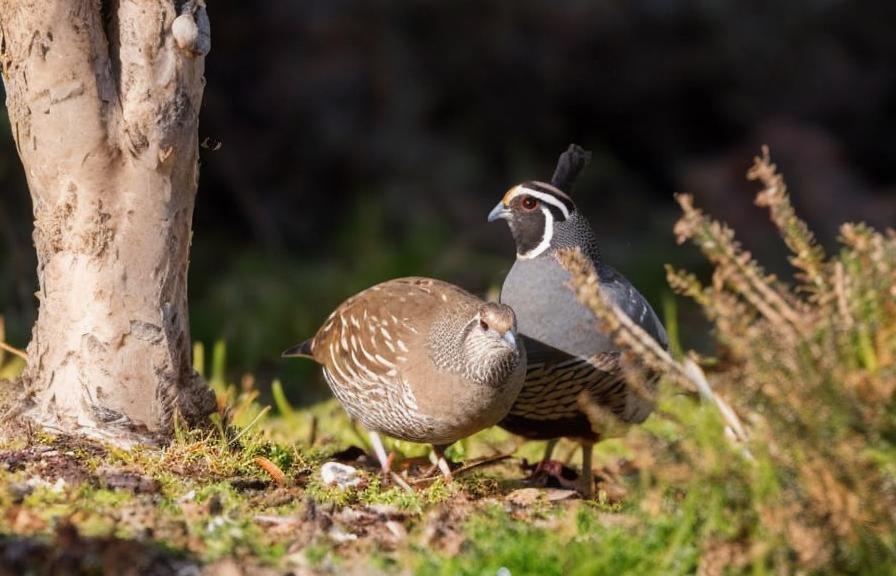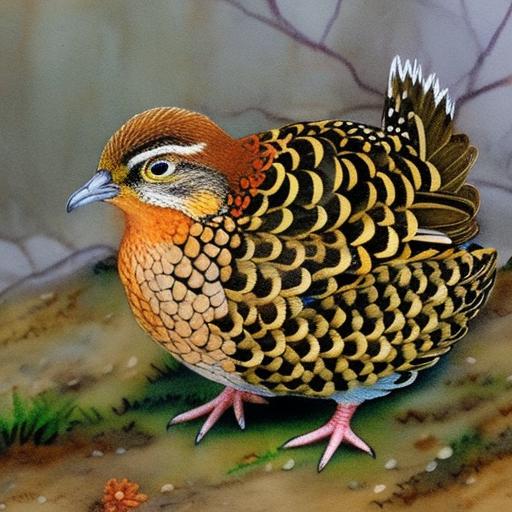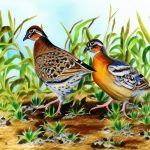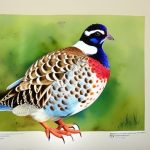Button quail, also known as Chinese painted quail, are small, ground-dwelling birds that are popular among aviculturists for their unique appearance and interesting behaviors. Breeding button quail can be a rewarding experience for bird enthusiasts, as these birds are relatively easy to care for and breed in captivity. In this article, we will explore the breeding age of button quail, the factors that affect their breeding age, signs of maturity, breeding practices, and health considerations for successful breeding. Understanding these aspects is crucial for anyone interested in breeding button quail and ensuring the well-being of the birds and their offspring.
Key Takeaways
- Button quail breeding is a popular hobby due to their small size and low maintenance requirements.
- Button quail reach breeding age at around 6-8 weeks old, but it is best to wait until they are at least 3 months old to ensure successful breeding.
- Factors affecting breeding age include genetics, diet, and living conditions, so it is important to provide a healthy and stress-free environment for the quail.
- Signs of maturity in button quail include the development of bright and colorful plumage, as well as the behavior of the quail showing interest in mating.
- Breeding practices for button quail involve providing a suitable nesting area, proper diet, and monitoring the breeding pairs for successful egg laying and incubation.
- Health considerations for breeding button quail include regular check-ups, providing a balanced diet, and keeping the breeding area clean to prevent the spread of diseases.
- In conclusion, it is important to wait until button quail are at least 3 months old before breeding, and to provide a healthy and stress-free environment for successful breeding.
Understanding the Breeding Age of Button Quail
Button quail reach sexual maturity at a relatively young age compared to other bird species. Typically, button quail can start breeding as early as 6-8 weeks old, although it is generally recommended to wait until they are at least 10-12 weeks old before allowing them to breed. This allows the birds to fully develop and ensures a higher likelihood of successful breeding and healthy offspring. It is important to note that the breeding age can vary slightly depending on the individual bird and its overall health and development. Additionally, it is crucial to provide the birds with the appropriate environment and diet to support their growth and reproductive capabilities.
Factors Affecting Breeding Age
Several factors can affect the breeding age of button quail. One of the most significant factors is the overall health and well-being of the birds. Birds that are raised in optimal conditions with access to a balanced diet and proper care are more likely to reach breeding age earlier and have successful breeding outcomes. On the other hand, birds that experience stress, malnutrition, or inadequate living conditions may take longer to reach sexual maturity or may have difficulty breeding altogether. Additionally, genetics can play a role in determining the breeding age of button quail, as certain genetic traits may influence the development and reproductive capabilities of the birds.
Environmental factors such as temperature and lighting can also impact the breeding age of button quail. These birds are sensitive to changes in their environment, and fluctuations in temperature or inadequate lighting can affect their growth and development. It is essential to provide button quail with a stable and suitable environment to ensure that they reach breeding age in a timely manner. Lastly, social dynamics within a group of button quail can influence their breeding age. Birds that are kept in a harmonious and stress-free social setting are more likely to reach sexual maturity earlier compared to those that experience social conflicts or competition within their group.
Signs of Maturity in Button Quail
Recognizing the signs of maturity in button quail is crucial for determining when they are ready to breed. One of the most obvious signs of maturity is the physical appearance of the birds. Mature button quail will have fully developed plumage and will exhibit distinct coloration based on their gender. Males typically have more vibrant and contrasting colors compared to females, and they may also display certain courtship behaviors such as strutting and vocalizations when they are ready to breed. Females, on the other hand, will exhibit behaviors such as nesting and egg-laying when they reach maturity.
Another important sign of maturity in button quail is their overall behavior and interaction with other birds. Mature birds will engage in courtship rituals and may form pair bonds with specific individuals within their group. They may also exhibit territorial behaviors and defend their nesting areas from other birds. Additionally, mature button quail will display increased activity levels and may spend more time foraging for food and exploring their environment in preparation for breeding. Observing these behavioral cues can help determine when button quail are ready to breed and can aid in successful breeding practices.
Breeding Practices for Button Quail
When it comes to breeding button quail, there are several important practices to consider to ensure successful outcomes. First and foremost, it is essential to provide the birds with a suitable nesting area where they can lay and incubate their eggs. This can be achieved by placing nesting boxes or suitable materials such as hay or shredded paper in their enclosure. It is important to monitor the nesting area regularly to ensure that it remains clean and safe for the birds and their eggs.
In addition to providing a suitable nesting area, it is crucial to maintain a balanced male-to-female ratio within a group of button quail to prevent aggression and ensure successful breeding. A ratio of one male to two or three females is generally recommended to minimize competition among males and provide females with adequate mating opportunities. It is also important to observe the birds’ behavior closely during the breeding process to identify any signs of aggression or stress and take appropriate measures to address these issues.
Furthermore, providing a nutritious diet is essential for supporting the breeding process and ensuring the health of the birds and their offspring. A diet rich in protein, vitamins, and minerals is crucial for egg production and chick development. Additionally, providing access to calcium supplements can help prevent egg-binding in female button quail, which is a common issue during the breeding process. By implementing these breeding practices, aviculturists can increase the likelihood of successful breeding and raise healthy button quail offspring.
Health Considerations for Breeding Button Quail

Maintaining the health of button quail is paramount when it comes to breeding these birds. Providing a clean and well-maintained environment is crucial for preventing diseases and ensuring the well-being of the birds. Regular cleaning of the enclosure, including removing soiled bedding and providing fresh water and food, is essential for preventing the spread of pathogens and maintaining a healthy living space for the birds.
In addition to environmental considerations, it is important to monitor the overall health of the birds during the breeding process. This includes observing their behavior, appetite, and physical condition on a regular basis. Any signs of illness or distress should be addressed promptly by consulting a veterinarian with experience in avian care. It is also important to provide the birds with access to veterinary care for routine check-ups and preventive measures such as vaccinations and parasite control.
Furthermore, providing a balanced diet that meets the nutritional needs of breeding button quail is essential for supporting their reproductive health. This includes offering a variety of foods such as high-quality seeds, insects, fruits, and vegetables to ensure that the birds receive essential nutrients for egg production and chick rearing. Additionally, providing access to grit or small stones can aid in digestion and support overall health. By prioritizing the health of breeding button quail, aviculturists can increase the likelihood of successful breeding outcomes and raise healthy offspring.
Conclusion and Recommendations for Breeding Age
In conclusion, understanding the breeding age of button quail is essential for anyone interested in breeding these unique birds. By considering factors that affect breeding age, recognizing signs of maturity, implementing appropriate breeding practices, and prioritizing health considerations, aviculturists can increase the likelihood of successful breeding outcomes and raise healthy button quail offspring. It is important to provide button quail with a suitable environment, balanced diet, and proper care to support their growth and reproductive capabilities. Additionally, monitoring the health of the birds and addressing any issues promptly is crucial for successful breeding. By following these recommendations, aviculturists can enjoy the rewarding experience of breeding button quail while ensuring the well-being of these fascinating birds.
If you’re considering breeding button quail, it’s important to understand their breeding age and behavior. Button quail typically reach sexual maturity at around 6-8 weeks old, but it’s essential to provide them with the right conditions for successful breeding. For more information on the breeding habits of quails and how to optimize their breeding environment, check out this insightful article on poultrywizard.com. Understanding the nuances of button quail breeding can lead to a successful and rewarding experience.
FAQs
What is the breeding age for button quail?
The breeding age for button quail is typically around 2 to 3 months old.
At what age do button quail reach sexual maturity?
Button quail reach sexual maturity at around 2 to 3 months of age.
How can you determine the gender of button quail at breeding age?
The gender of button quail can be determined by observing their physical characteristics. Males typically have a more pronounced bib and make a distinct “bob-white” call, while females are usually smaller and have a less prominent bib.
What is the best age to start breeding button quail?
The best age to start breeding button quail is around 3 to 4 months old, once they have reached sexual maturity.
Are there any health considerations to keep in mind when breeding button quail at a young age?
It is important to ensure that young button quail are in good health before breeding, as breeding at a young age can put additional stress on their bodies. It is recommended to provide a balanced diet and proper housing to support their reproductive health.
Meet Walter, the feathered-friend fanatic of Florida! Nestled in the sunshine state, Walter struts through life with his feathered companions, clucking his way to happiness. With a coop that’s fancier than a five-star hotel, he’s the Don Juan of the chicken world. When he’s not teaching his hens to do the cha-cha, you’ll find him in a heated debate with his prized rooster, Sir Clucks-a-Lot. Walter’s poultry passion is no yolk; he’s the sunny-side-up guy you never knew you needed in your flock of friends!







